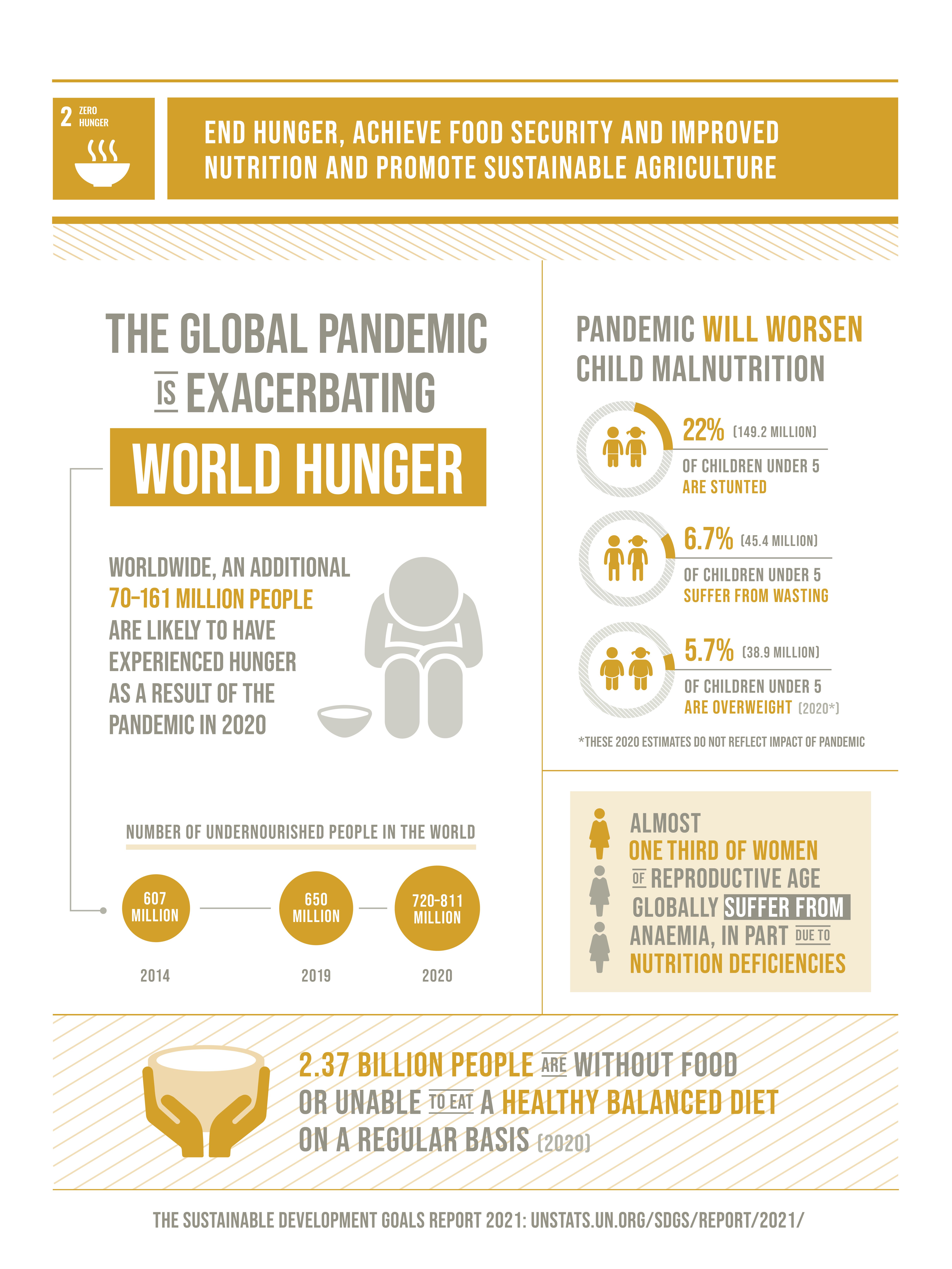



Current estimates show that nearly 690 million people are hungry, or 8.9 percent of the world population – up by 10 million people in one year and by nearly 60 million in five years.
The world is not on track to achieve Zero Hunger by 2030. If recent trends continue, the number of people affected by hunger would surpass 840 million by 2030.
According to the World Food Programme, 135 million suffer from acute hunger largely due to man-made conflicts, climate change and economic downturns. The COVID-19 pandemic could now double that number, putting an additional 130 million people at risk of suffering acute hunger by the end of 2020.
With more than a quarter of a billion people potentially at the brink of starvation, swift action needs to be taken to provide food and humanitarian relief to the most at-risk regions.
At the same time, a profound change of the global food and agriculture system is needed if we are to nourish the more than 690 million people who are hungry today – and the additional 2 billion people the world will have by 2050. Increasing agricultural productivity and sustainable food production are crucial to help alleviate the perils of hunger.
Facts and Figures:-
- Current estimates are that nearly 690 million people are hungry, or 8.9 percent of the world population – up by 10 million people in one year and by nearly 60 million in five years.
- The majority of the world’s undernourished – 381 million – are still found in Asia. More than 250 million live in Africa, where the number of undernourished is growing faster than anywhere in the world.
- In 2019, close to 750 million – or nearly one in ten people in the world – were exposed to severe levels of food insecurity.
- An estimated 2 billion people in the world did not have regular access to safe, nutritious and sufficient food in 2019.
- If recent trends continue, the number of people affected by hunger will surpass 840 million by 2030, or 9.8 percent of the global population.
- 144 million children under age 5 were affected by stunting in 2019, with three quarters living in Southern Asia and sub-Saharan Africa.
- In 2019, 6.9 per cent (or 47 million) children under 5 were affected by wasting, or acute undernutrition, a condition caused by limited nutrient intake and infection.
2.1 By 2030, end hunger and ensure access by all people, in particular the poor and people in vulnerable situations, including infants, to safe, nutritious and sufficient food all year round.
2.2 By 2030, end all forms of malnutrition, including achieving, by 2025, the internationally agreed targets on stunting and wasting in children under 5 years of age, and address the nutritional needs of adolescent girls, pregnant and lactating women and older persons.
2.3 By 2030, double the agricultural productivity and incomes of small-scale food producers, in particular women, indigenous peoples, family farmers, pastoralists and fishers, including through secure and equal access to land, other productive resources and inputs, knowledge, financial services, markets and opportunities for value addition and non-farm employment.
2.4 By 2030, ensure sustainable food production systems and implement resilient agricultural practices that increase productivity and production, that help maintain ecosystems, that strengthen capacity for adaptation to climate change, extreme weather, drought, flooding and other disasters and that progressively improve land and soil quality.
2.5 By 2020, maintain the genetic diversity of seeds, cultivated plants and farmed and domesticated animals and their related wild species, including through soundly managed and diversified seed and plant banks at the national, regional and international levels, and promote access to and fair and equitable sharing of benefits arising from the utilization of genetic resources and associated traditional knowledge, as internationally agreed.
2.A Increase investment, including through enhanced international cooperation, in rural infrastructure, agricultural research and extension services, technology development and plant and livestock gene banks in order to enhance agricultural productive capacity in developing countries, in particular least developed countries.
2.B Correct and prevent trade restrictions and distortions in world agricultural markets, including through the parallel elimination of all forms of agricultural export subsidies and all export measures with equivalent effect, in accordance with the mandate of the Doha Development Round.
2.C Adopt measures to ensure the proper functioning of food commodity markets and their derivatives and facilitate timely access to market information, including on food reserves, in order to help limit extreme food price volatility.
Even before the COVID-19 pandemic, the number of people experiencing hunger globally and suffering from food insecurity had been rising gradually since 2014. The pandemic has increased the vulnerabilities and inadequacies of global food systems, potentially leaving hundreds of millions more people chronically undernourished and making the goal of ending hunger more difficult to achieve. Between 83 and 132 million more people may already have been pushed into chronic hunger in 2020. In addition, countries and territories around the world continue to struggle with multiple forms of malnutrition.
It is estimated that almost 690 million people around the world experienced hunger in 2019, equivalent to 8.9 per cent of the world population – an increase of nearly 60 million in five years. Updated estimates due for publication in July 2021 will provide a more recent picture of the effects of the pandemic on hunger.
An estimated 2 billion people, 25.9 per cent of the world population, were affected by moderate or severe food insecurity in 2019, up from 22.4 per cent in 2015. The fastest rise was recorded in Latin America and the Caribbean, although the highest levels were registered in sub-Saharan Africa.
Globally, 149.2 million children under the age of 5, some 22 per cent of all children, suffer from stunting (low height for age) according to the latest estimates available for 2020,2 a decrease from 24.4 per cent in 2015. However, these figures may rise as a result of continued constraints on access to nutritious food and essential nutrition services during the pandemic, the full impact of which may take years to manifest.
In 2020, wasting (low weight for height) and overweight affected 6.7 per cent (45.4 million) and 5.7 per cent (38.9 million) of children under the age of 5, respectively. Wasting will be one of the conditions most affected by the pandemic in the short term: around 15 per cent more children than estimated may have suffered from wasting as a result of a decline in household wealth and disruptions in the availability and affordability of nutritious food and essential nutrition services. Childhood overweight (high weight for height) may also rise in some countries and territories where unhealthy foods replaced fresh, nutritious foodstuffs and restrictions on movement constrained opportunities for physical activity for long periods.
In women, anaemia increases the risk of adverse maternal and neonatal outcomes. In 2019, the global prevalence of anaemia was 29.9 per cent in women of reproductive age, 29.6 per cent in non-pregnant women and 36.5 per cent in pregnant women. The prevalence was higher in Central and Southern Asia, at 47.5 per cent in women of reproductive age.
The average agricultural output per labour day of small-scale food producers in the limited number of countries and territories surveyed is lower than that of large - scale producers, who also earn up to two or three times the annual income of smallscale producers. In almost all countries and territories surveyed, households headed by males achieve higher labour productivity and earn larger annual incomes compared to their female counterparts.
Global holdings of plant genetic resources for food and agriculture in 2020 reached 5.7 million accessions conserved in 831 gene banks by 114 countries and territories and 17 regional and international research centres. Although the total number of global holdings has risen, the growth rate decreased over the past 10 years, reaching its lowest level in 2020.
The world is still far off target for maintaining the genetic diversity of farmed and domesticated animals, either in the field or in gene banks. The risk status of 61 per cent of local livestock breeds remains unknown. Of the limited number surveyed, 74 per cent are deemed to be at risk of extinction, yet there is only sufficient material in gene banks for 203 out of a global total of 7,700 local livestock breeds to reconstitute the breed in the event of its extinction.
While the share of agricultural aid has remained constant at about 5 percent, it has more than doubled in volume since 2002, with total disbursements amounting to $13 billion in 2019.
A steady downward trend has been observed in export subsidy outlays notified to the World Trade Organization (WTO). Total notified annual outlays fell from a peak of $6.7 billion in 1999 to $138 million in 2018. In December 2015, WTO members adopted the ministerial decision on export competition, formally agreeing to eliminate all forms of agricultural export subsidy entitlements.
At the global level, the number of countries and territories afflicted by high food prices decreased from 2014 to 2019, with the notable exception of some countries in Central, Southern and Western Asia as well as Northern Africa, owing to the reduced domestic availability of staple foods and to currency depreciations.
We all want our families to have enough food to eat what is safe and nutritious. A world with zero hunger can positively impact our economies, health, education, equality and social development. It’s a key piece of building a better future for everyone. Additionally, with hunger limiting human development, we will not be able to achieve the other sustainable development goals such as education, health and gender equality.
You can make changes in your own life—at home, at work and in the community—by supporting local farmers or markets and making sustainable food choices, supporting good nutrition for all, and fighting food waste. You can also use your power as a consumer and voter, demanding businesses and governments make the choices and changes that will make Zero Hunger a reality. Join the conversation, whether on social media platforms or in your local communities.
[Source:- www.un.org]